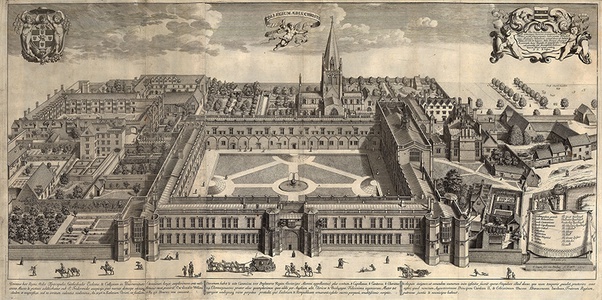| Method | |
| Artist | David Loggan |
| Published | D. Loggan fecit, cum Privilegio S.R.M.tis 1673 [Oxford, 1675] |
| Dimensions | Image 400 x 812 mm, Plate 412 x 812 mm |
| Notes |
A large scale view of Christ Church College from the first edition of 'Oxonia Illustrata' published in 1675. One of the earliest and most sought after views of Christ Church, the college is depicted before the construction of Tom Tower. Arguably the most impressive print of the college ever produced, Loggan's engraving, the largest plate in his Oxonia Illustrata, offers a fascinating snapshot of the college's buildings and walled gardens in the seventeenth century and prior to the many major additions made to the college over the centuries to follow. David Loggan (1635-1692), artist and engraver, was born at Danzig in 1635. He may have learnt the art of engraving from Simon van den Passe in Denmark and from Hendrik Hondius in the Netherlands. Loggan followed Hondius's sons to England in about 1653, and by 1665 he was residing at Nuffield, near Oxford, and had made the acquaintance of the antiquarian Anthony Wood. On 30 March 1669 he was appointed Engraver to the University of Oxford, with an annual salary of twenty shillings. He married a daughter of Robert Jordan, Esq. of Kencote Hall in Oxfordshire in 1671, and in 1672 they had a son, John Loggan, who later graduated from Trinity College. The marriage probably produced another son, William Loggan, about whom little is known except that he was responsible for a satirical print of Father Peters and the Jesuits, published in 1681. David Loggan took up residence in Holywell in about 1671, prior to matriculating at the University. In 1675 he was naturalised as an Englishman. The remainder of his life was spent mostly in London, where he worked as an agent and art dealer, and as Engraver to the University of Cambridge, a position he attained in 1690, two years before his death. Loggan's two great works were a series of architectural bird's eye plans of the colleges and public buildings of Oxford and Cambridge, the Oxonia Illustrata, published in 1675, and its rarer sister Cantabrigia Illustrata, which appeared at some point previous to 1690. Following Loggan's death, the plates were acquired and reprinted by Henry Overton in 1705 and c.1710 respectively. Oxonia Illustrata was the first illustrated book on Oxford and one of the major works of the 17th century. The book was the product of several years of devoted and conscientious effort in which Loggan was assisted by his pupil Robert White. The Oxonia Illustrata was intended as a companion work to Historia Antiquitates Universitatis Oxoniensis by Anthony Wood, with whom Loggan had become acquainted some years earlier. Although clearly intended as companions, with pagination suggesting that they were even parts of the same volume, for some unknown reason both books were published independently. Condition: A good impression, printed on two sheets and joined. Pressed vertical folds, as issued. Repaired tears to top and left margins, three into image. Small infilled patch of loss to top left sheet. Repair and creasing to bottom margin and fold, into image. Mark to sky to right sheet and two iron inclusions one to the left sheet and one to the right. |
| Framing | unmounted |
| Price | £2,500.00 |
| Stock ID | 53228 |

